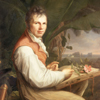Featured Articles

American Puritan Writing
Why is it that the bedrock of American culture was laid by that very small confederation of colonies in the north-east, an offshoot of the larger movement of English Protestantism? The essay sets out to delineate the varied reasons behind the rise to prominence of this white, English-speaking patriarchal community as traditional “forefathers” of the modern nation. Providing a brief history of how Puritanism came about as an essentially middle-class, economically dynamic and literate social phenomenon, it also looks at the sources of internal (sin and its myriad manifestations) and external (Indian indigenous populations) conflict that has helped solidify it as a unitary political and spiritual movement. The article traces the various kinds of literary cultures it has fostered, from sermons, jeremiads and providential histories, to poetry and drama, journals and autobiography, as well as treatise debates which offer fascinating discussions of the relationship between church and state.

Apartheid: Part I
This is part of a cycle of eight interconnected articles that take an in-depth look at the origins and development of this discriminative system of political governance, tracing its history from the initial conflicts of the British-Boer wars at the turn of the 20th century to the rise and intensification of Afrikaner nationalism and the reaction against Apartheid in South Africa between 1951 and 1993. The final section offers a useful Annex enumerating and briefly describing the various both pre-1948 and post-1948 Legislative Acts related to Apartheid. The articles are best read together, but we initially offer this first section, which provides the introduction and preliminary historical context, with further articles in the series being made available in the coming months.

Review of Alexander von Humboldt: Perceiving the World, West Lafayette, Indiana: Purdue University Press, 2023
The first review article published by The Literary Encyclopedia, it offers a brilliant insight into a fascinating new collection on the work of Alexander von Humboldt, the ur-scientist, written by one of the leading experts in his life and work. Together with the biographical entry on Humboldt, and the recommended readings associated to it, the LE thus offers a solid introduction into the work of this quintessential Enlightenment figure and the manifold aspects of his rich and diverse intellectual heritage.

The Golden Age of Children’s Literature
The article offers a comprehensive review of that very productive period of children’s literature in the English-speaking world roughly extending between 1865 and World War I, and including many titles and authors that remain household names today, still read in their original form and recognizable through their many adaptations: Lewis Carroll’s Alice in Wonderland, May Alcott’s Little Women, Mark Twain’s The Adventures of Tom Sawyer, Anna Sewell’s Black Beauty, Rudyard Kipling’s The Jungle Book, L. Frank Baum’s The Wonderful Wizard of Oz, Beatrix Potter’s The Tale of Peter Rabbit and many others. The key change from previous works addressed to a predominantly young readership, the author shows, is a shift from instruction to delight, an emphasis on pleasure and creativity, aesthetic innovation, and more complex child-characters. The survey highlights what continues to be a rich area for inquiry and debate, while at the same time discussing how we might expand our understanding of the literature of the Golden Age to produce a more inclusive canon.

The mistress and maid figures in European literature
This is a fascinating comparative essay which looks at a topic that has rarely been discussed in such depth and breadth, even though, as its author remarks, “the mistress-maid binary has provided an inexhaustible source of thematic content in narrative fiction as well as in visual art, drama and film”. Accordingly, the article proposes a succinct excursion across world literary cultures, from the Bible to Don Quixote, passing through 18th and 19th century English and French literatures, down to contemporary narratives such as Atwood’s The Handmaid’s Tale, Rushdie’s Midnight Children or Namwali Serpell’s The Old Drift. The richness of texts surveyed in the article is only equalled by the elegance of its style and the variety of critical perspectives it embraces.


